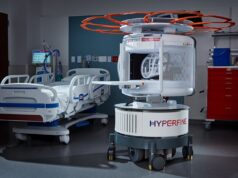Stroke treatment is time-sensitive. Every minute counts. Every delay in decision-making affects patient outcome. Given this, JM Ospel and colleagues from the University of Calgary, Canada, write that it is imperative that stroke physicians are able to quickly and easily interpret imaging protocols. In a recently published study, Ospel and colleagues discuss a new multiphase CT angiography (CTA) display format that incorporates vascular information “from all phases of the multiphase CTA series in a single time-variant colour map”, which aims to facilitate imaging interpretation, especially for less experienced readers.

Through the paper published in the American Journal of Neuroradiology (AJNR), they explain that while CT perfusion (CTP) may be “particularly popular” due to the colour maps, standard multiphase CTA shares a similar diagnostic and prognostic ability, but requires further expertise. Thus, while mitigating the requirement for such expertise, the authors posit that the novel tool can facilitate “assessment of collateral flow, detection of distal and multiple intracranial occlusions, differentiation of pseudo-occlusion from real occlusion, and assessment of flow relevance of stenoses, anterograde and retrograde flow patterns, and clot permeability”.
In the article, Ospel and others present exemplary cases of multiphase CTA and compare them with conventional multiphase CTA and CTP. They note that imaging data were obtained from a prospective observational multicentre study that aims to analyse the incremental value of multiphase CTA and CTP in acute ischaemic stroke, consisting of 569 subjects.
“Colour-coded multiphase CTA summation maps were created on a work-station using FastStroke [GE Healthcare],” write the authors, adding that, “The software fuses the vascular information from the different CTA phases into a single colour-coded view called ColorViz.”
In terms of evaluating pial arterial filling, Ospel et al write that multiphase CTA is a “reliable tool” to do so, and add that several studies have demonstrated that it reduces interrater reliability and has “excellent predictive validity” regarding clinical outcome. For these reasons, it was used in the recently concluded ESCAPE NA1 trial (results to be presented at the International Stroke Conference on 20 February, 2020) and continues to be used in the TEMPO 2 trial.
While acknowledging that pial artery filling and collateral flow are “relatively easy” to assess on conventional multiphase CTA, the authors speculate that the colour-coded maps of the novel multiphase CTA “further facilitate interpretation by combining all information into a single image and using a colour-coded display format”.
Moreover, Ospel and colleagues argue that although large-vessel occlusions are comparably simple to spot of single-phase CTA, “distal occlusions are often missed”. They write that both CTP and multiphase CTA have been shown to improve distal-vessel-occlusion detection, while the colour-coded display format and the ability to merge the vascular information in one series “further facilitates [the] detection of distal vessel occlusions on multiphase CTA.
“The hallmark of distal occlusion in colour-coded multiphase CTA maps is areas of delayed flow manifesting as pial vessels in green and blue within one vascular territory,” the authors propose.
They allude to another advantage of the novel tool: colour-coded multiphase CTA summation maps. These can detect both distal anterior cerebral artery and posterior cerebral artery occlusions. Such territories are sometimes not fully covered by the 4-, 8-, or 10cm CTP slab that is frequently used with older generation scanners. Additionally, Ospel et al comment: “Multiphase CTA does not succumb to skull base artifacts to the same extent as CTP and can therefore better visualise the posterior circulation.”
The concluding remarks see the authors maintain that colour-coded multiphase CTA summation maps “may facilitate easier assessment of acute stroke pathology”, while ColorViz may be particularly useful for less experienced readers. Nevertheless, Ospel and colleagues hope to further validate and improve on each of the imaging constructs that ColorViz multiphase CTA provides, in the ESCAPE NA1 dataset.













